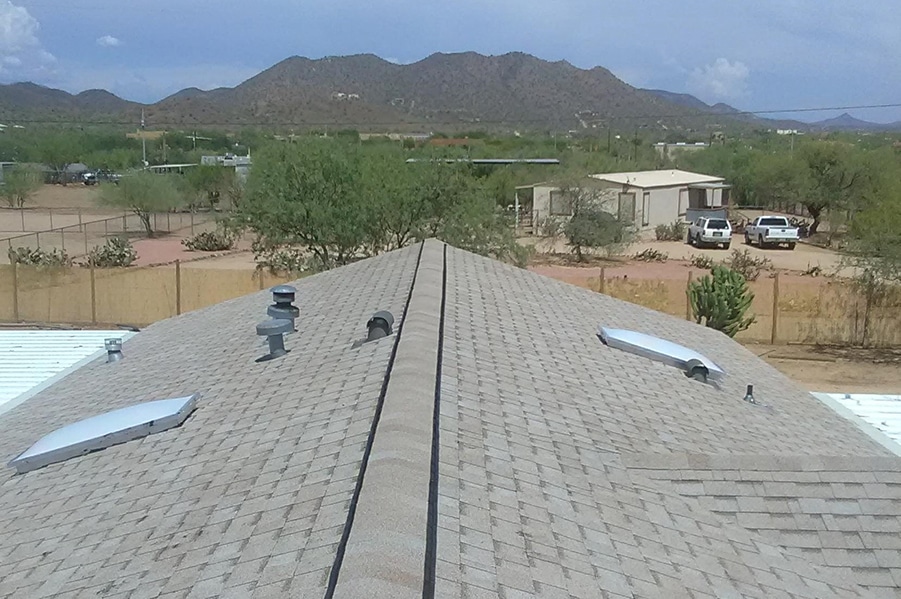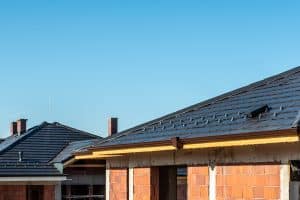One of the most important components of your roofing system is the ventilation it provides to your home. Roof vents play an essential part in keeping your home functioning efficiently and a healthy living space. The main goal of attic ventilation is to circulate the hot, moist air out of the attic in the most efficient manner.
Understanding the types of roof vents will help you decide what is best for your home and all of its occupants. We are going to walk throught the six types of roofing vents today along with when they are best to be used.
6 Types of Roofing Vents
1. Ridge Vent
Exactly as they sound, ridge vents run the length of the ridgeline of your roof. Designed to replace the ridge shingles or tiles, these vents boost air flow while still preventing rain or debris from entering. As they are installed at the highest point of your home, ridge vents are highly effective at allowing warm air to escape from your attic. Ridge vents are often installed in conjunction with soffit vents to create a vacuum effect in your attic.
2. Box Vent
These low-profile boxes are installed toward the top of your roof to allow warm air out of your attic. Typically, more than one box is necessary to provide adequate ventilation to your attic. Box vents come in several material and color options to best fit the style of your home and roof. Box Vents are an alternative to ridge vents, but they also work best when installed along with soffit ventilation.
3. Soffit Vent
Installed on the underside of your roof’s eaves, soffit vents draw fresh outside air into your attic. While a soffit vent can be installed by themselves, they work best when paired with either a ridge or box vent. Working together, the soffit vent allows cool outside air to be drawn into the attic and pushes the hot, humid air through the ridge or box vent back outside.
4. Turbine Vent
Turbine vents are an incredibly effective roof vent option. As the turbine spins, warm air is pulled out of the attic. These vents are a great option as they can be installed almost anywhere on the roof. Two drawbacks of turbine vents are they are not very effective on non-windy days and the moving parts tend to break over time.
5. Gable Vent
Installed on the outside wall of your attic, gable vents provide functionality and aesthetics to your home. Similar to other roofing vents, gable vents are designed to keep water, debris, and critters outside while providing ventilation to your attic. Gable vents are often installed alongside soffit or ridge vents, especially for large, complex attics. These vents do not require much maintenance and can be relatively cheap to install.
6. Power Vent
As its name would suggest, a power vent requires electricity in order to function. This low-profile dome is installed directly to your roof and wired into your home’s electrical system. For maximum efficiency, a power vent is controlled by a thermometer and humidistat so the vent is not constantly running. Power vents are available in several colors to match your roof.
Professional Guidance
Adding ventilation to your attic can help increase your home’s efficiency and support a healthy living space. Working with a professional roofer will not only offer the best option for your home, but they can also properly install the vents. Craven Construction is available to assess your ventilation needs and provide you with a FREE estimate for ventilation installation. Contact our office today to speak to an experienced roofer and schedule your appointment.
Is your roof in need ventilation?
About Craven Construction
Craven Construction is dedicated to providing our customers with honest and reliable roofing services. With over two decades of residential and commercial experience, we are here to serve you and all of your roofing needs.
Our team of experienced roofers is licensed and knowledgeable in working with all types of roofing. We offer high quality roofing services and are capable of getting your project completed in a timely, efficient manner.


